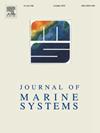Seasonal and decadal variations in nutrients and organic carbon in the lower Huanghe River under drastically changing water-sediment regimes
IF 2.5
3区 地球科学
Q2 GEOSCIENCES, MULTIDISCIPLINARY
引用次数: 0
Abstract
The Huanghe (Yellow) River is well known for its sediment-laden river waters, and it is also a typical large river deeply imprinted by human activities. Surface water samples were collected monthly from March 2019 to October 2022 at the Luokou station in its lower reaches, to elucidate the seasonal variation patterns of POC (particulate organic carbon) in SPM (suspended particulate matter), nutrients, and DOC (dissolved organic carbon) ready to be transported to the sea. The annual water-sediment regulation scheme (WSRS), generally carried out in June and July since 2002 at the Xiaolangdi reservoir, induced pulsed changes in both water discharge and sediment contents downstream that destroyed the natural sediment-water balance, so that the chemical parameters of sediments (POC (%), POC/PN (particulate nitrogen), δ13C in POC, and δ15N in PN) at the lower reaches did not show clear seasonal variation patterns anymore. At the same time, however, concentrations of NO3−, SiO32−, NO2−, and DOC still maintained apparent seasonal variations. Concentrations of NO3−, SiO32−, NH4+, and NO2− as well as DOC displayed significantly decreasing trends after 2000, which were different from their decadal trends of increasing in the last century. These new trends, owing to the successful implementation of the environmental protection projects, as well as to the prolonged retention times of river waters after the constructions of a large number of reservoirs over the river basin, reflected the profound transformation and evolution of the Huanghe River aquatic ecosystems just occurring recently.
剧烈变化的水沙状态下黄河下游养分和有机碳的季节和年代际变化
黄河以其含沙量大而闻名,也是一条典型的深受人类活动影响的大河。2019年3月至2022年10月,在其下游的罗口站每月采集地表水样品,以阐明SPM(悬浮颗粒物)中POC(颗粒有机碳)、营养物质和DOC(溶解有机碳)准备输送到海洋的季节变化规律。自2002年以来,小浪底水库每年6、7月实施的年度水沙调节方案(WSRS)引起下游水量和沙量的脉冲变化,破坏了天然的沙水平衡,使得下游沉积物的化学参数(POC(%)、POC/PN(颗粒氮)、POC中的δ13C和PN中的δ15N)不再呈现明显的季节变化模式。与此同时,NO3−、SiO32−、NO2−和DOC的浓度仍保持明显的季节变化。2000年以后,NO3−、SiO32−、NH4+、NO2−和DOC的浓度呈显著的下降趋势,与上个世纪的年代际上升趋势不同。环境保护工程的成功实施,以及流域上大量水库建设后河水滞留时间的延长,反映了近期黄河水生生态系统发生的深刻变化和演变。
本文章由计算机程序翻译,如有差异,请以英文原文为准。
求助全文
约1分钟内获得全文
求助全文
来源期刊

Journal of Marine Systems
地学-地球科学综合
CiteScore
6.20
自引率
3.60%
发文量
81
审稿时长
6 months
期刊介绍:
The Journal of Marine Systems provides a medium for interdisciplinary exchange between physical, chemical and biological oceanographers and marine geologists. The journal welcomes original research papers and review articles. Preference will be given to interdisciplinary approaches to marine systems.
 求助内容:
求助内容: 应助结果提醒方式:
应助结果提醒方式:


